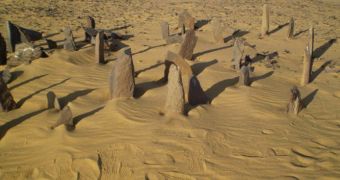Experts have recently demonstrated that the ancient Egyptian site of Nabta Playa is in fact one of the oldest astronomical observatories in the world. Archaeologists believe that the location may have been in use between 6,000 and 8.000 years ago.
The new discovery was made after an astrophysicist analyzed the way stones were laid about at the site. Thomas G. Brophy says that three of them, which are also part of the calendar circle, are aligned perfectly to reflect the position of the three stars in Orion's Belt.
At the same time, the interior of the calendar circle contains an additional three rocks, which the expert say are the exact replicas of the positions the shoulders and head stars of Orion had in the night sky.
We must always keep in mind that the ancient sky looked differently than it does today. When we account for how the stars shifted their positions, then the correlation immediately becomes visible, the astrophysicist explains.
According to Brophy, the circle itself was constructed in such a manner so as to reflect the motion of objects in the sky over a precession cycle, which spans thousands of years. This conceptual representation that was discovered at Nabta Playa is tremendously complex.
It also hints at the fact that priests – or whoever was in charge of constructing the observatory – had a really good grasp of what was going on in the skies above. This happened at a time when other civilizations were still unaware of even basic concepts related to celestial mechanics.
Using a variety of scientific measurements, Brophy and his research group managed to establish correspondences between Sirius, Arcturus, Alpha Centauri and the Belt of Orion, on one hand, and the stone placements at the ancient Egyptian site, on the other hand.
This observations site may have also functioned as a necropolis, experts believe, saying that herdsmen in the area most likely used it to look at the stars, and determine where to bury their cattle.
“The repetitive orientation of megaliths, stele, human burials and cattle burials reveals a very early symbolic connection to the north,” Brophy explains, quoted by Daily Galaxy.
“The symbolism embedded in the archaeological record of Nabta Playa in the fifth millennium BC is very basic, focused on issues of major practical importance to the nomads: cattle, water, death, earth, sun and stars,” the expert and his team add.

 14 DAY TRIAL //
14 DAY TRIAL //